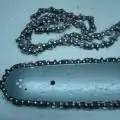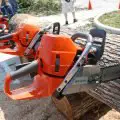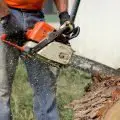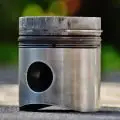A chainsaw is possibly the most durable tool you own. It is powerful and durable, but it must be carefully maintained on a regular basis to remain in great operating order.
In the beginning, parts of a chainsaw may appear complicated and even mysterious. But here’s the good news: a chainsaw is a simple machine that doesn’t require much maintenance.
It is the connecting point between the engine and the chain. Its purpose is to disengage when the engine is idling, preventing the chain from moving. As soon as the engine starts, it engages, allowing the chain to cut.
In this article, we’ll discuss all the possible causes of a faulty chainsaw clutch, possible repairs, and a step-by-step guide on replacing your clutch!
Table of Contents
- What Causes Chainsaw Clutch Failure?
- How to Tell if a Chainsaw Clutch Is Bad? Signs of a Bad Clutch
- How Do You Fix a Clutch on a Chainsaw?
- When Should You Replace a Clutch in a Chainsaw?
- How to Replace a Clutch on a Chainsaw?
- FAQs (Frequently Asked Questions)

What Causes Chainsaw Clutch Failure?
A chainsaw clutch transmits power from the engine to the cutting chain. It is placed between the engine and the drive sprocket and is made up of multiple metal plates held together by springs. As the engine’s RPM rises, centrifugal force causes the plates to open and interact with the driving sprocket, causing the cutting chain to move.
If the clutch fails to function properly, it can lead to a variety of issues. As a result, it is critical to understand what causes chainsaw clutch failure so that preventive measures can be implemented in a timely manner.
The surface of the clutch shoes is coated with a high-friction liner, similar to the brake shoes in a car. Each time the clutch engages, this lining wears down some amount.
As the chainsaw is used regularly, the lining gets too thin to accomplish its job, and the clutch slips. This occurs for two reasons: first, the lining gets so thin that the clutch cannot make contact with the drum, and second, the shoe surface becomes slick.
In the eyes of the saw operator, the chain comes to a halt whenever it cuts. Oil pollution can also potentially cause clutch damage.
How to Tell if a Chainsaw Clutch Is Bad? Signs of a Bad Clutch
Certain indicators can indicate whether the clutch needs to be repaired or replaced. If the clutch is not engaged at the correct RPM, the chainsaw may bog down when under load.
Furthermore, if the clutch plates are damaged or worn out, they can slip, causing the chainsaw to kick back, which can be extremely dangerous for the operator. As a result, it is critical to understand when your chainsaw clutch is failing. Here are several warning indications that your chainsaw clutch is on its last legs:
1. Engine Stalling
Another indicator of a faulty chainsaw clutch is when the chainsaw motor begins to stall. It usually happens when the blade is not correctly attached to the engine. As a result, the engine is unable to work normally. If your chainsaw’s motor is stalling, get it fixed before you start cutting wood.
2. Chainsaw Not Cutting Properly
If your chainsaw isn’t cutting properly, there’s a problem with the clutch. When the clutch fails to function properly, the chainsaw may cut unevenly or not at all.
3. Clutch Slipping
When the saw begins to slip, this is one of the most common symptoms that the chainsaw clutch is failing. It signifies that the blade is no longer closely attached to the engine, and as a result, the saw will not perform properly. If you feel your chainsaw starting to slip, you should take it to a repair shop as soon as possible.
4. Chainsaw Vibrates While Running
When you’re cutting with a chainsaw and you notice that your tool is vibrating a lot, it’s a sign that the chainsaw clutch is broken. It is natural for a saw to shake, but excessive vibrations indicate that the chainsaw clutch is faulty!
5. Chainsaw Stops While Cutting
If your chainsaw used to stop while cutting, there could be several causes, one of which is a faulty clutch.
6. The Chainsaw Seems to be Running Too Fast or Too Slow
Your chainsaw’s abnormally fast or slow operation is a red flag. For example, if the chainsaw runs too fast or too slowly, it strongly indicates that your chainsaw’s clutch is broken and has to be repaired!
7. Loud Grinding Noise
When you try to start the chainsaw, you may notice that it makes a loud noise. This is an indication of a worn-out clutch that should never be ignored. The starter cord may also become more difficult to pull.
How Do You Fix a Clutch on a Chainsaw?
Although in most cases, if your clutch is slipping or making a grinding noise when you start your chainsaw, you may need to replace the clutch, there is a potential that the problem can be resolved temporarily. If the problem is limited to a single component of the clutch assembly, you can remove it with a clutch removal tool like this one from Husqvarna, and attempt to repair it:
Prices pulled from the Amazon Product Advertising API on:
Product prices and availability are accurate as of the date/time indicated and are subject to change. Any price and availability information displayed on [relevant Amazon Site(s), as applicable] at the time of purchase will apply to the purchase of this product.
You could try one of the following:
- Replace the throw-out bearing: You must replace the throw-out bearing whenever you repair the clutch, as any new component added to the clutch requires a new bearing.
- The flywheel can be resurfaced, but if there are grooves caused by warping, heat discoloration, or oil contamination, it may need to be replaced.
- Replace the Pilot Bushing: If the clutch is sliding, consider changing the bushing near the crankshaft.
A faulty clutch can cause the saw to stall or even stop completely, so keep an eye out for symptoms of damage and repair the clutch component if the problem persists.
When Should You Replace a Clutch in a Chainsaw?
A thorough chainsaw maintenance checklist is vital for keeping your chainsaw clutch in good working order. This provides you with a good indication of when a chainsaw component needs to be repaired or replaced.
If the clutch is not operating properly, it is preferable to replace the entire assembly rather than just one component. For example, if the clutch shoes wear out, it is advisable to replace the entire clutch assembly because the inside of the drum is likely to be worn out as well.
If you hear a grinding noise when starting your chainsaw or see it vibrating, it is necessary to inspect the clutch for any problems. Your chainsaw may suddenly cease working, or you may encounter kickback, which can be quite dangerous. All of these are clear indications that your chainsaw’s clutch needs to be replaced.
How to Replace a Clutch on a Chainsaw?
If you hear grinding noises when starting the chainsaw or feel the clutch slipping, it is a strong indication that the chainsaw clutch is faulty. Don’t be concerned if you don’t know how to repair or replace the clutch. Here’s how to replace your chainsaw’s clutch on your own:
Replacing a Bad Chainsaw Clutch
Total Time: 15 minutes
Remove Chainsaw Bar and Chain
The sprocket is located directly behind the chain cover. Remove the chainsaw bar and chain first before replacing the chainsaw clutch. You can reach the chainsaw clutch and sprocket after removing the chainsaw bar and chain.
Remove Top Cover and Spark Plug
Remember to bind up the piston before removing the chainsaw clutch to remove the sprocket. Because if you try to remove the clutch, the piston will continue to spin, making removal impossible. Remove the top cover and the spark plug to accomplish this.
Bind Up the Piston
You can simply bind up the chainsaw piston now that the spark plug is out of the way. You can accomplish this by inserting a rope or shoelace within the cylinder. However, leave enough rope length outside the cylinder so that you may simply remove the rope later.
Pull Starter Rope
Pull the starter rope to bring the piston to the top dead center. However, the piston cannot continue to the top dead center. The rope is getting in the way and tying it up. You can also use the piston binding tool if you have one.
Remove the Clutch
It is now safe to remove the clutch. The chainsaw clutch can be removed with a specific tool. However, if you don’t have one in your toolbox at home, a screwdriver will suffice. Take the screwdriver and set it on the edge of the clutch before striking it with a hammer. It will allow the clutch to be released. You may now easily remove the chainsaw clutch and sprocket.
Replace the Clutch and Rebuild Chainsaw
After you’ve removed the old or damaged clutch, it’s time to install the new clutch and reassemble your tool. All of the preceding procedures must now be completed in reverse order.
Other troubleshooting-related pages:
- Troubleshooting Your Chainsaw: Common Problems with Chainsaws
- Chainsaw Piston Damage – Causes & Repair Solutions
- Chainsaw Won’t Start Has Spark and Fuel? Possible Causes & Solutions
- Chainsaw Hard to Pull With Spark Plug-In? Fixes & Causes of a Chainsaw With Too Much Compression
- Chainsaw Bogs Down When Cutting? Here’s How To Solve & Why It’s Bogging Down
FAQs (Frequently Asked Questions)
How to tell if a chainsaw clutch is bad?
If your saw starts forcefully, stops regularly, produces a lot of vibration, or throws chains frequently, the clutch may be worn or damaged. A faulty clutch can be hazardous since excessive vibration can cause the saw to topple while in use.
What causes chainsaw clutch failure?
As the chainsaw is used more frequently, the lining wears down and the clutch slips. This happens for two reasons: first, the lining wears down to the point where the clutch can no longer make contact with the drum, and second, the shoe surface becomes slick.
Can you run a chainsaw without a clutch?
It would not be able to run without a clutch. Running the chainsaw without a clutch entails directly connecting the chain sprocket to the motor. This keeps the chain moving even when the engine is turned off.







